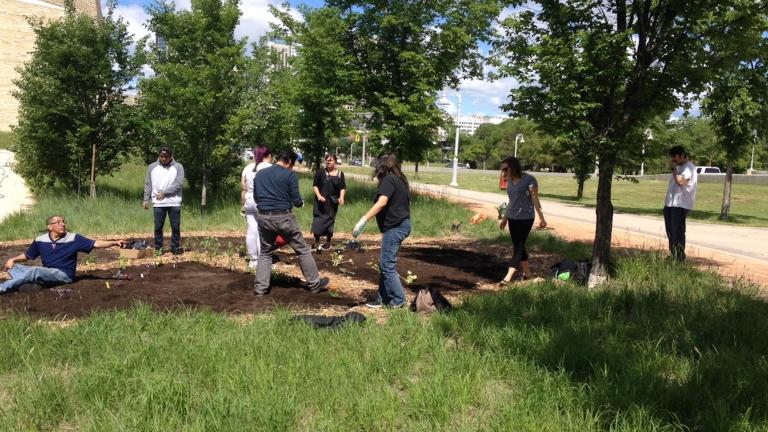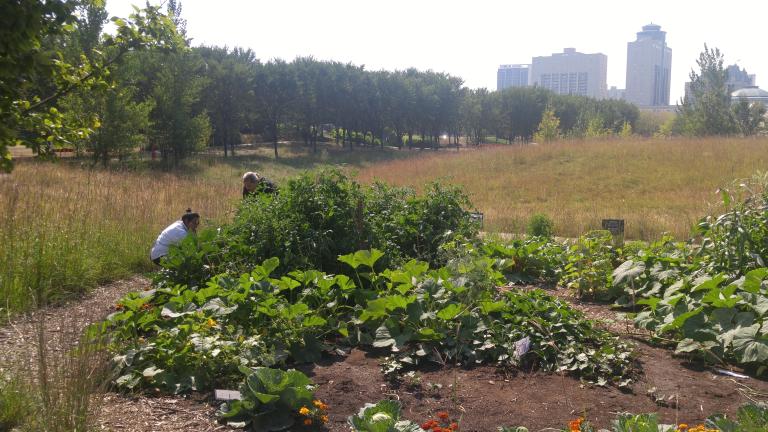My partner and I have a small garden just outside the front door of our home. I will admit that it’s not much to look at.
Planting a seed: Creating a community garden at the Museum
By Matthew McRae
Published: September 19, 2017
Tags:

Photo: CMHR, John Kozlowski
Story text
We’ve only grown two tomato plants, some basil, oregano and a few flowers, all in small pots. Nonetheless, I feel that there’s something wonderful about preparing, cooking and eating food you’ve grown yourself – and I’m not alone in feeling this way. Statistics Canada found that in 2013, more than half of Canadian households (57%) reported they grew fruits, herbs, vegetables or flowers for personal use in the last twelve months.
It isn’t just household gardens that are popping up across the country, however – community gardens are also experiencing healthy growth in Canada. A community garden is a single piece of urban land where plants are grown collectively by a group of people. They come in all shapes and sizes, from rooftop gardens to street‐side plots and they are tended by all sorts of different people.
It makes sense that community gardens can be linked to human rights. Article 25 of the Universal Declaration of Human Rights states that everyone has the right to a standard of living adequate for the health and well‐being of themselves and their family – including food. Many community gardens are planted with the intention of reducing food insecurity and improving health, especially in low‐income neighbourhoods that have limited access to fresh produce. Which is why we’re excited about the community garden planted on the Northeast side of the Museum this summer.
The Museum was honoured to work with the Council for Aboriginal Human Resources Development (CAHRD) to create the garden. Students of CAHRD’s horticultural program have seeded and tended various plants in the garden, including corn, squash and traditional herbs. The garden itself is circular in shape, and divided into four sections meant to look like a traditional medicine wheel.
Everyone is welcome to take what they need from the garden. CAHRD will take whatever remains to their commercial kitchen where students can use the produce to make nutritious meals.
For Indigenous peoples in Canada, maintaining a connection to the land is very important. Articles 25 and 26 of the United Nations Declaration on the Rights of Indigenous Peoples (UNDRIP) state that Indigenous peoples have the right to maintain and strengthen both their spiritual and physical relationships to their traditional lands. The Museum is located on Treaty One Territory and in the heartland of the Métis people – and so it is good that members of Winnipeg’s Indigenous community are involved in the creation and development of the garden.
Damon Johnston is the President of the Aboriginal Council of Winnipeg and a member of the Museum’s Standing Indigenous Advisory Council. He’s also been the project leader for CAHRD’s involvement in the Museum’s community garden. He notes that, as well as providing a connection to the land, the garden also speaks to the need for greater food security in Indigenous communities:
"One of the big challenges in Indigenous communities is access to affordable nutrition or vegetables or herbs with high nutrition levels that contribute to becoming healthier. This is being seen as a sort of demonstration project that could be expanded to other sites, to First Nations communities across Manitoba," he notes.

The garden in full bloom.
Photo: CMHR, Matthew McRaeJohnston also sees the community garden as a small step on the path of improving relationships between Indigenous and non‐Indigenous Canadians. He said the best way to achieve that is "through real connection, through people coming together in healthy spaces and then truly getting to know and appreciate who each other are."
By creating a community garden, the Museum has planted seeds we hope will continue to grow and thrive in coming years, producing both tangible and intangible harvests.
My walk to work takes me by the garden every morning and it is always a welcome sight. It is a small garden, but I am hopeful it will continue to grow in the years to come.
Suggested citation
Suggested citation : Matthew McRae. “Planting a seed: Creating a community garden at the Museum.” Canadian Museum for Human Rights. Published September 19, 2017. https://humanrights.ca/story/planting-seed-creating-community-garden-museum